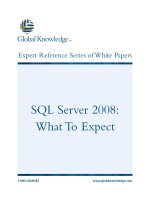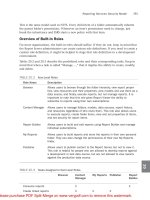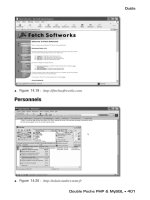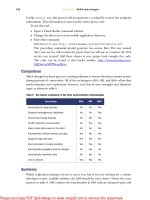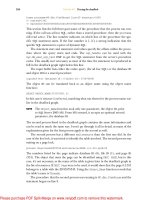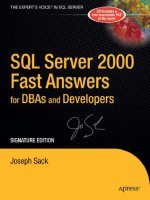Tài liệu SQL Puzzles & Answers- P9 doc
Bạn đang xem bản rút gọn của tài liệu. Xem và tải ngay bản đầy đủ của tài liệu tại đây (292.57 KB, 27 trang )
302 PUZZLE 72 SCHEDULING SERVICE CALLS
zip_code CHAR(5) NOT NULL);
CREATE TABLE Services
(client_id INTEGER NOT NULL REFERENCES Clients,
emp_id CHAR(9) NOT NULL REFERENCES Personnel,
start_time DATETIME NOT NULL,
FOREIGN KEY (client_id, emp_id, start_time)
REFERENCES (client_id, emp_id, start_time),
end_time DATETIME, null is an open job
CHECK (start_time)< end_time),
sku INTEGER NOT NULL,
PRIMARY KEY (client_id, emp_id, start_time, sku)
);
Notice the long natural key. If you do not declare it that way, you will
have no data integrity. But newbies will get scared and use things like
IDENTITY as a key and never worry about data integrity.
CREATE TABLE Inventory
(sku INTEGER NOT NULL PRIMARY KEY,
stock_descr VARCHAR(50) NOT NULL,
tax_rate DECIMAL(5,3) NOT NULL,
duration INTEGER NOT NULL);
The real trick is to create a Personnel Schedule table that holds all
available dates for each employee.
CREATE TABLE PersonnelSchedule
(emp_id CHAR(9) NOT NULL
REFERENCES Personnel(emp_id),
avail_start_time DATETIME NOT NULL,
avail_end_time DATETIME NOT NULL,
CHECK (avail_start_time < avail_end_time),
PRIMARY KEY (emp_id, avail_start_time));
Answer #2
We need someone with available time between the scheduled periods for
the job. In this query, the available time must overlap or exactly contain
the service call period. The dummy employee is a handy trick to let the
dispatcher see a list of available employees via the PK-FK relationship.
Please purchase PDF Split-Merge on www.verypdf.com to remove this watermark.
PUZZLE 72 SCHEDULING SERVICE CALLS 303
SELECT P.emp_id,
S.client_id,
S.scheduled_start_time,
S.scheduled_end_time,
FROM ScheduledCalls AS S,
PersonnelSchedule AS P
WHERE S.emp_id = ‘{xxxxxxx}’
AND P.emp_id <> ‘{xxxxxxx}’
AND S.scheduled_start_time
BETWEEN P.avail_start_time
AND P.avail_end_time;
AND S.scheduled_end_time
BETWEEN P.avail_start_time
AND P.avail_end_time;
But beware! This will produce all of the available personnel. We will
have to leave it to the dispatcher to make the actual assignments.
Please purchase PDF Split-Merge on www.verypdf.com to remove this watermark.
304 PUZZLE 73 A LITTLE DATA SCRUBBING
PUZZLE
73 A LITTLE DATA SCRUBBING
This came in as a data-scrubbing problem from “Stange” at SQL
ServerCentral.com. He is importing data from a source that sends him
rows with all
NULLs. And, no, the source cannot be modified to get rid of
these rows on the other side of the system. After staging this data into
SQL, he wants to identify the
NULL rows and remove them. His fear was
that he would have to hard-code:
SELECT *
FROM Staging
WHERE col1 IS NULL
AND col2 IS NULL
AND col3 IS NULL
etc.
AND col100 IS NULL;
Answer #1
He was playing around with passing the <tablename> as a parameter
and then interfacing with the Schema Information tables to identify all
columns in said table, get a list of them, then build the query and see if
all of these columns are NULL or not. In SQL Server, that would look
something like this, but each SQL product would be a little different:
SELECT *
FROM syscolumns
WHERE id
= (SELECT id
FROM sysobjects
WHERE name = <tablename>);
Answer #2
Chris Teter and Jesper both proposed a highly proprietary looping
cursor that went through the schema information tables to build
dynamic SQL and execute. This was not only nonrelational and highly
proprietary, but also very slow.
I am not going to print their code here for the reasons just given, but
it shows how programmers fall into a procedural mind-set.
Please purchase PDF Split-Merge on www.verypdf.com to remove this watermark.
PUZZLE 73 A LITTLE DATA SCRUBBING 305
Answer #3
Just do a “cut and paste” from the system utility function that will give
you all the column names and drop it into this statement template: Any
SQL product will have such a function (e.g.,
EXEC sp_columns in SQL
Server).
DELETE FROM Staging
WHERE COALESCE
(col1, col2, col3, , col100) IS NULL;
This is about as fast as it will get. It also demonstrates that it helps to
read the manual and find out what the SQL vendors have given you.
Most of these utilities will define a
<column> and its options (NULL-able,
DEFAULT, key, indexed, etc.) in one row, so you just lift out the name and
add a comma after it.
It takes less than five seconds, even for large tables. You will spend
more time writing code that will probably fail when the next release of
our database comes out and the schema information tables are a little
different.
However, you will have to remember to update your SQL every time
there is a change to the table or your query will fail every time you have a
new release of your system, which will happen much more often than
releases of your schema information tables.
Please purchase PDF Split-Merge on www.verypdf.com to remove this watermark.
306 PUZZLE 74 DERIVED TABLES OR NOT?
PUZZLE
74 DERIVED TABLES OR NOT?
Allen Davidson was trying to join three tables with two LEFT OUTER
JOINs and an INNER JOIN to get the SUM() of a few of the columns. Can
his query be rewritten to avoid the derived tables?
CREATE TABLE Accounts
(acct_nbr INTEGER NOT NULL PRIMARY KEY);
INSERT INTO Accounts VALUES(1), (2), (3), (4);
Please notice that the following, Foo and Bar, are not tables, since
they have no keys.
CREATE TABLE Foo
(acct_nbr INTEGER NOT NULL
REFERENCES Accounts(acct_nbr),
foo_qty INTEGER NOT NULL);
INSERT INTO Foo VALUES (1, 10);
INSERT INTO Foo VALUES (2, 20);
INSERT INTO Foo VALUES (2, 40);
INSERT INTO Foo VALUES (3, 80);
CREATE TABLE Bar
(acct_nbr INTEGER NOT NULL
REFERENCES Accounts(acct_nbr),
bar_qty INTEGER NOT NULL);
INSERT INTO Bar VALUES (2, 160);
INSERT INTO Bar VALUES (3, 320);
INSERT INTO Bar VALUES (3, 640);
INSERT INTO Bar VALUES (3, 1);
His proposed query:
SELECT A.acct_nbr,
COALESCE(F.foo_qty, 0) AS foo_qty_tot,
COALESCE(B.bar_qty, 0) AS bar_qty_tot
FROM Accounts AS A
LEFT OUTER JOIN
Please purchase PDF Split-Merge on www.verypdf.com to remove this watermark.
PUZZLE 74 DERIVED TABLES OR NOT? 307
(SELECT acct_nbr, SUM(foo_qty) AS foo_qty
FROM Foo
GROUP BY acct_nbr) AS F
ON F.acct_nbr = A.acct_nbr
LEFT OUTER JOIN
(SELECT acct_nbr, SUM(bar_qty) AS bar_qty
FROM Bar
GROUP BY acct_nbr) AS B
ON F.acct_nbr = B.acct_nbr;
This does just fine, but are there other answers?
Results
acct_nbr foo_qty_tot bar_qty_tot
=================================
1 10 0
2 60 160
3 80 961
4 0 0
Answer #1
R. Sharma found a way to avoid one derived table, but not both:
SELECT A.acct_nbr,
COALESCE(SUM(F.foo_qty), 0) AS foo_qty_tot,
COALESCE(MAX(B.bar_qty), 0) AS bar_qty_tot
FROM (SELECT * FROM Accounts) AS A
LEFT OUTER JOIN
(SELECT * FROM Foo) AS F
ON A.acct_nbr = F.acct_nbr
LEFT OUTER JOIN
(SELECT acct_nbr, SUM(bar_qty) AS bar_qty
FROM Bar
GROUP BY acct_nbr) AS B
ON A.acct_nbr = B.acct_nbr
GROUP BY A.acct_nbr;
This will work since the derived table will always get one row per
account number so the
MAX() will ensure the right value. The first one, a
derived table, won’t be needed because of the one-to-many relationship
Please purchase PDF Split-Merge on www.verypdf.com to remove this watermark.
308 PUZZLE 74 DERIVED TABLES OR NOT?
between accounts and Foo and the grouping done on
Accounts.acct_nbr.
Answer #2
Here is my answer. First, assemble the two nontables with the little-used
FULL OUTER JOIN, which will give you a table with Foo and Bar
combined and then we add the Account information.
SELECT A.acct_nbr,
COALESCE (SUM(F.foo_qty), 0) AS foo_qty_tot,
COALESCE (SUM(B.bar_qty), 0) AS bar_qty_tot
FROM Accounts AS A
LEFT OUTER JOIN
(Foo AS F
FULL OUTER JOIN
Bar AS B
ON F.acct_nbr = B.acct_nbr)
ON A.acct_nbr = F.acct_nbr
GROUP BY A.acct_nbr;
The other queries have started with the accounts, added nontable
Foo, and then added nontable Bar to the mix. Notice that the
OUTER
JOIN
is a table! Wow! Maybe those RDBMS principles are useful after all.
I am hoping that the Foo-Bar
JOIN table will be relatively small, so
the
OUTER JOIN will be quick and they can go into main storage.
Please purchase PDF Split-Merge on www.verypdf.com to remove this watermark.
PUZZLE 75 FINDING A PUB 309
PUZZLE
75 FINDING A PUB
This is a common problem for simple maps. The original version of this
problem was based on the location of pubs in a city, so that when we got
kicked out of one pub, we could locate nearby ones to which to crawl.
The map we use is an (x, y) Cartesian system, which looks like this:
CREATE TABLE PubMap
(pub_id CHAR(5) NOT NULL PRIMARY KEY,
x INTEGER NOT NULL,
y INTEGER NOT NULL);
What I would like is an efficient method for finding the group of
points within a neighborhood.
Answer #1
The immediate solution is to use the Cartesian distance formula,
d = √((x1-x2)
2
+ (y1- y2)
2
), and to define a neighborhood as a certain
radius from the pub, as the crow flies.
SELECT B.pub_id, B.x, B.y
FROM PubMap AS A,
PubMap AS B
WHERE :my_pub <> B.pub_id
AND SQRT (POWER((A.x - B.x), 2)
+ POWER((A.y - B.y), 2))
<= :crawl_distance;
But if you look at the math, you can save yourself some of the
calculation costs. A little algebra tells us that we can square both sides.
SELECT B.pub_id, B.x, B.y
FROM PubMap AS A,
PubMap AS B
WHERE :my_pub <> B.pub_id
AND :my_pub = A.pub_id
AND (POWER((A.x - B.x), 2)
+ POWER((A.y - B.y), 2))
Please purchase PDF Split-Merge on www.verypdf.com to remove this watermark.
310 PUZZLE 75 FINDING A PUB
<= POWER(:crawl_distance, 2);
Squaring a number is usually pretty fast, since it can now be done as
integer multiplications.
Answer #2
If you are willing to give up a direct distance (circular neighborhood
model) and look for a square neighborhood, the math gets easier:
SELECT A.pub_id, B.pub_id
FROM PubMap AS A, PubMap AS B
WHERE :my_pub <> B.pub_id
AND :my_pub = A.pub_id
AND ABS(A.x - B.x) <= :distance
AND ABS(A.y - B.y) <= :distance;
Answer #3
Another approach that is inspired by the square neighborhoods
approach is to divide the plane into a large square grid. Each grid cell
holds several nodes—think of a typical city map. When a node is located
in one quadrant, then the nine adjacent cells centered on his cell would
have the nearest neighbor, so I only did a distance formula on the points
in those cells.
CREATE TABLE PubMap
(pub_id CHAR(5) NOT NULL PRIMARY KEY,
x INTEGER NOT NULL,
y INTEGER NOT NULL,
cell_x INTEGER NOT NULL,
cell_y INTEGER NOT NULL);
It meant carrying an extra pair of cell coordinates, but it saved
searching all the nodes—the nodes of 9 cells versus approximately
150,000 nodes in the whole map.
SELECT N2.pub_id, N2.x, N2.y
FROM PubMap AS N1, PubMap AS N2
WHERE :my_pub <> N2.pub_id
AND :my_pub = N1.pub_id
Please purchase PDF Split-Merge on www.verypdf.com to remove this watermark.
PUZZLE 75 FINDING A PUB 311
AND N2.cell_x IN (N1.cell_x-1, N1.cell_x, N1.cell_x+1)
AND N2.cell_y IN (N1.cell_y-1, N1.cell_y, N1.cell_y+1);
Use this as a derived table for a limited neighborhood in the first
query in place of the B alias, and you will have a good answer for a
large map.
Please purchase PDF Split-Merge on www.verypdf.com to remove this watermark.
This Page Intentionally Left Blank
Please purchase PDF Split-Merge on www.verypdf.com to remove this watermark.
Index
A Absentees
Absenteeism table, 6, 7
Calendar table, 8
discharging personnel, 4
long-term illnesses, 7
puzzle, 4–8
table, 4
ABS() function, 103, 104, 237
AGE()
function, 7
Age ranges for products puzzle, 261–
62
Aggregate functions, on empty sets,
31
Airlines and pilots
exact relational division, 90
pilots table, 88
planes table, 88
puzzle, 88–91
relational division, 89
ALL() predicate, 255
Alpha data puzzle, 19–20
ANDs, nested, 265
Anesthesia puzzle, 9–15
Anesthesiologist procedures
concurrent, 12–13
elimination, 11
overlapping, 10
payment, 9
Armes, Jim, 146
Attenborough, Mary, 197
Available seats puzzle, 34–36
Average
moving, 152–54
rule, 174
sales wait puzzle, 126–28
AVG() function, 123, 127, 174
B Backward-looking sums, 12
Badour, Bob, 209, 257
Barcodes
pseudoformula, 238–39
Please purchase PDF Split-Merge on www.verypdf.com to remove this watermark.
314 INDEX
puzzle, 237–41
set-oriented, declarative answer,
240–41
Becher, Johannes, 219
BETWEEN predicates, 3
in
CHECK() clause, 19
for durations, 39
for reading/maintaining code, 93
subqueries in, 187
temporal version, 22
Bin-packing problem, 288
Block of seats puzzle, 190–91
Blumenthal, Nigel, 148–51
Bose-Nelson solution, 242
Boxes
intersecting pairs, 257
n-dimensional, 257
puzzle, 257–60
Bragg, Tom, 112
Brouard, Frédéric, 106
Brown, Robert, 215
Buckley, Brian K., 141
Budgeted table, 210
Budgeting puzzle, 169–71
Budget versus actual puzzle, 208–11
Buying all products
deeply nested query, 130
puzzle, 129–31
tables, 129
C
Cady, C. Conrad, 208
Calculations
puzzle, 297–99
query text, 297
Calendar table, 8
Campbell, Brendan, 53
Cartesian distance formula, 309
CASE expressions, 32, 46
collapsing
SELECT statements
into, 54
ELSE NULL and, 102
GROUP BY clause and, 150–51
in LIFO-FIFO inventory puzzle,
285–87
optimization tricks, 46–47
self-joins and, 287
as
UNIONs
replacement, 110, 184
WHEN clauses, 47
WHERE clause, 219
CAST expression, 64
Catching the next bus
bus schedule, 282
puzzle, 280–82
table, 280
without comparisons, 281–82
Categories table, 176
CEILING() function, 193
Chacha, Yogesh, 29
Chains, 28
Characteristic functions, 46
CHECK() clause, 16–17, 28, 190
BETWEEN predicates in, 19
complex SQL in, 21
constraints, 19, 47, 182
subqueries and, 22, 191
substrings in, 19
Chupella, Jim, 4
Claims status puzzle, 48–52
defendant, 49
numeric claim sequence, 50
Clock table, 15
COALESCE() function, 32, 57, 65,
106, 136, 156
Please purchase PDF Split-Merge on www.verypdf.com to remove this watermark.
INDEX 315
to current timestamp, 300
parameter list inspection, 174
Collapsing table by columns puzzle,
215–17
Columns
alpha data, 19–20
collapsing tables by, 215–17
in
GROUP BY clause, 100
in
SELECT list, 100
Common table expression (CTE), 41,
63
gaps, 233
LIFO-FIFO inventory, 290
recursive, 233
sales promotion, 189
Comparison operators, 47
Comparison predicates, 105
Computing depreciation puzzle, 137–
40
Computing taxes
hierarchy, 132
puzzle, 132–36
table, 132, 133
taxing authorities, 134, 136
See also Taxes
Constraints
CHECK(), 19, 47, 182
FOREIGN KEY,
56
No_Overlaps, 191
PRIMARY KEY, 191
string, 222
testing, 165
UNIQUE, 2
Consultant billing puzzle, 141–44
Contained in or equal to, 115
Contiguous groupings puzzle, 254–56
ConwayMike, 64
COUNT(*), 90
in average sales wait puzzle, 128
in budgeting puzzle, 171
in personnel problem puzzle, 213
testing against, 162
COUNT (DISTINCT <expression>)
aggregate function, 203, 213
Counting fish puzzle, 172–75
Covering index, 296
CREATE TABLE statement, 1
CROSS JOINs,
89, 298
in getting all possible pairs, 163
as multiplication operator, 89
Curly brackets, 301
D Data
alpha, 19–20
false, 64
Database Programming & Design, xi,
115
Dataflow diagrams (DFDs)
bubbles, 112
diagram name, 112
flow lines, 112
puzzle, 112–14
table, 112
Data scrubbing
problem, 304
proprietary looping cursor, 304
puzzle, 304–5
system utility function, 305
Date, Chris, 64, 65, 89, 115
Dautbegovic, Dzavid, 40, 249
Davison, Allen, 306
DAYS() function, 127
DB2 On-Line Magazine, 91
Please purchase PDF Split-Merge on www.verypdf.com to remove this watermark.
316 INDEX
DBMS magazine, xi
DECODE() function, 47
DELETE statement, 5
DeMorgan’s law, 96
DENSE_RANK() function, 85
DENSE_RANK() OVER (<window
expression>) function, 224
Depreciation
computing, 137–40
cost table, 137
lifespan, 137
manufacturing hours table, 137
De Rham, Abbott, 179
Derived tables
avoiding, 307
puzzle, 306–8
Desai, Bipin C., 115
DISTINCTs, 114, 131
Double duty puzzle, 148–51
Duplicates
dropping incorrectly, 222
potential, 218–20
row, 179–80
Dwyer, Trevor, 105
E
Elements table, 164
Employees
billings, 143
candidate skills, 75
effective date, 143
firing rules, 4–5
mechanic, 71
numbering rows within, 67
salary changes, 61–62
severity points, 4
total charges, 141–42
total earnings, 37
workload, 37
Employment agency
candidates, 75, 78
DOT, 76
job orders, 76
puzzle, 75–79
Empty sets
aggregate functions on, 31
returning, 120
Ersoy, Cenk, 45
Esperant, 129
EXACT function, 1
EXCEPT ALL operator, 229
EXCEPT operator, 118, 258
EXISTS() predicate, 90, 130
for checking “blocking pairs,” 270
nested, 91
Extrema functions, 53
F Federl, Carl C., 96
FIFO (first in, first out). See LIFO-FIFO
inventory
Finding a pub
Cartesian distance formula, 309
puzzle, 309–11
square neighborhood, 310
Finding equal sets puzzle, 115–20
Finding mode computation puzzle,
123–25
Find last two salaries puzzle, 60–68
First Normal Form (1NF), 55, 104
Fiscal year tables puzzle, 1–3
Flags, plus/minus representation, 34
Flancman, Alan, 103
FLOOR() function, 193
Please purchase PDF Split-Merge on www.verypdf.com to remove this watermark.
INDEX 317
FOREIGN KEY constraint, 56
Friends of Pepperoni, 183
FROM clauses, 58, 231
Frontera, Mark, 169
FULL OUTER JOINs, 57, 115, 308
Fundamentals of Database Systems, 115
G
Gallaghar, Karen, 92
Gammans, Scott, 21
Ganji, Kishore, 58
Gaps
CTE, 233
no, 228
puzzle (version one), 227–29
puzzle (version two), 230–333
starting/ending values, 227
Gilson, John, 215
Gora, Mike, 158
Graduation
Categories table, 176
puzzle, 176–78
Greedy algorithms, 288
GROUP BY clause, 59, 79, 99, 203, 206
in aggregates creation, 100
CASE expression and, 150–51
columns, 100
inside correlated subqueries, 98
sort invocation, 146–47
Grouped tables, 79
Groups
contiguous, 254–56
empty, 170
non-
NULL values in, 110
Gusfield, Dan, 278
H Halloran, Donald, 254
Harakiri, Mikito, 257, 258
Harvey, Roy, 86, 89, 148
HAVING clauses, 38, 83, 128
extending, 161–62
predicates, reducing, 188
Hiner, Ron, 224
Hotel reservations puzzle, 21–23
Hotel room numbers
puzzle, 224–26
table, 224
WATCOM approach, 224, 225
working table data, 224
Hughes, Bert C., 14
Hughes, Dave, 43
I
Indexes, covering, 296
Indexing, 97
IN predicate, 164
expansion into equality predicate,
105
as test for membership, 115
INSERT INTO statement, 23
INSERT
statements, 22
Insurance losses
correct policy tables, 158–59
customer table, 158
losses table, 159
puzzle, 158–62
Intelligent Enterprise, xi
International Standard Book Number
(ISBN), 203
Interpolation, 122
Interpolation, linear, 122
Please purchase PDF Split-Merge on www.verypdf.com to remove this watermark.
318 INDEX
An Introduction to Data Base Systems,
115
Introduction to Database Systems, 90
Inventory adjustments puzzle, 145–47
Irving, Robert W., 278
IsNumeric() function, 238
ISO naming conventions, 301
Israel, Elizabeth, 261
J Jaiswal, Anilbabu, 174
Jilovec, Gerhard F., 137
Joe Celko’s Trees and Hierarchies in SQL
for Smarties, 136
JOINs
subqueries in, 210
See also specific types of JOINs
Journal table, 157
Journal updating puzzle, 155–57
Julian workdays, 8
Junk mail puzzle, 80–81
K Kass, Steve, 255
Keeping a portfolio puzzle, 24–28
Knuth, Donald E., 279
Kubu, Sissy, 192
Kuznetsov, Alexander, 101, 119, 131
L Landlord puzzle, 92–93
Larsen, Sheryl, 91
Lawrence, Peter, 196, 197
LEFT OUTER JOINs, 70, 92, 171,
210, 248
joining tables with, 306
on two columns, 175
Legal events, ordering, 49
LIFO-FIFO inventory
bin-packing problem, 288
bins in table, 289
CTE, 290
derived table and
CASE
expression, 285–87
puzzle, 283–91
table, 283
UPDATE statements, 287
LIFO (last in, first out). See LIFO-FIFO
inventory
LIKE clause, 276
LIKE predicate, 20
Linear interpolation, 122
M Magazine
distribution database table, 94
newsstand selection, 94–95
puzzle, 94–103
Manko, Gerard, 69
Manufacturing cost, 137, 138
MAX() function, 17, 31–32, 38, 43, 54,
59, 124
highest non-
NULL value, 110
as safety check, 171
values, 210–11
values, optimizer finding, 120
McDonald, J. D., 188
McGregor, Keith, 94
Mechanics puzzle, 69–74
Medal, Leonard C., 9, 48, 149
Melissa Data, 220
Mello, Vinicius, 197
Merging time periods puzzle, 34–36
Please purchase PDF Split-Merge on www.verypdf.com to remove this watermark.
INDEX 319
Milestone
puzzle, 107–11
self-joins, 108
service delivery, 107
subquery expressions, 108–9
table structure, 107
UNION ALL operators, 109–10
MIN() function, 17, 54, 245
values, 210–11
values, optimizer finding, 120
MINUS operator, 118
Missing values, 54
Mode computation, finding, 123–25
Mode() function, 125
MOD() function, 245–46
modulus, changing, 253
as vendor extension, 246
Moreau, Tom, 231
Moreno, Francisco, 51, 59, 81, 100,
118, 139, 210
Moving average
holding, 152
predicate construction, 153
puzzle, 152–54
Multiple-column row expressions, 98
N Nebres, Diosdado, 135
Nested function calls, 239
Nested
ORs, 265
Nested sets, 136
Nested subqueries, 258
Nguyen, Linh, 143
Noeth, Dieter, 67, 68, 232
NOT condition, 11
NOT EXISTS predicate, 130, 205
maximizing performance, 276
set difference replacement, 118
traditional test, 117
NOT NULL, 1, 47
NULLs, 5, 87
handling, 124
for missing values, 54
multiple, 30
return of, 174
Numbering functions, 224
NUMBERS(*) function, 224
O Ocelot software, 19
Odegov, Andrey, 44, 65
OLAP/CTE, 68
OLAP functions, 43
running totals, 147
SQL-99, 153
support, 85
Omnibuzz, 232, 233
One in ten
puzzle, 103–6
table, 103
ORDER BY clause, 85, 226
ORs, nested, 265
Orthogonality, 123, 124
OUTER JOINs, 56–57, 63
Gupta-style extended equality, 58
persistent/transient in, 92
with
RANK() function, 66
in
Select clauses, 145
self, 245
OVERLAPS predicate, 22
OVER() window clause, 147
Please purchase PDF Split-Merge on www.verypdf.com to remove this watermark.
320 INDEX
P Padding, 239
Pairs of styles puzzle, 179–82
Paradox table, 69
Pascal, Fabian, 60, 64
Pepperoni pizza puzzle, 183–85
Permutations
defined, 163
factorial number of, 163
puzzle, 163–68
Personnel problem puzzle, 212–14
Personnel Schedule table, 302
Petersen, Raymond, 126
Playing the ponies
horse name table, 223
puzzle, 221–23
table, 221
Pointer chains, 25
Poole, David, 261
POSITION function, 151
Potential duplicates
defined, 218
expression arrangement, 219
mailing list cleanup packages, 220
puzzle, 218–20
Predicates
ALL, 255
BETWEEN, 3, 19, 22, 39, 93
comparison, 105
EXISTS, 90, 91, 130
HAVING clause, 188–89
IN, 105, 115, 164
LIKE, 20
NOT EXISTS, 117, 118, 130
OVERLAPS, 22
SIMILAR TO, 239
PRIMARY KEY constraint, 191
Primary keys
covering index, 296
multiple columns, 175
Printers
common, 30, 32
load balancing, 30
LPT numbers, 31
scheduling, 29–33
unassigned, 32
Puzzles. See SQL puzzles
R Race, Daren, 212
RANK() function
defined, 85
hidden sort, 67
OUTER JOINs with, 66
Raval, Nayan, 248
REFERENCING clause, 72
Referential integrity, 70
Regular expression predicate, 20
Relational division, 89
COUNT(*) version, 90
exact, 90
REPLACE() function, 243
REPLICATE() function, 243
Report formatting
experimental table, 246
puzzle, 244–53
two-across solution, 245
Reservations
puzzle, 190–91
rule, 190
table, 190
Rightsizing, 16
Robertson, Gillian, 130
Romley, Richard, 13, 31, 36, 39, 54,
63, 98, 132, 176, 188, 269
Please purchase PDF Split-Merge on www.verypdf.com to remove this watermark.
INDEX 321
ROW_NUMBER() function, 43, 85
Rows
adding/deleting, 294
“blocking pairs,” 270
duplicate, 179–80
harvesting, 194
inserted, 5
Running totals, 147
Russian peasant’s algorithm, 192, 197,
199
S Sales promotion
clerk performance, 186
CTE, 189
puzzle, 186–89
Samet, Alan, 41
Scalar subqueries, 121, 170
inside function calls, 156
results, 171
See also Subqueries
Scalzo, Bert, 6
Scheduling printers puzzle, 29–33
Scheduling service calls
double booking, 300
Personnel Schedule table, 302
process, 300
puzzle, 300–303
Security badges puzzle, 16–18
Sedgewick, Robert, 168
Select list
columns, 100
improper creation, 181
subqueries in, 145
SELECT statement, 26–27, 173
collapsing, 54
as grouped query, 63
independent scalar, 71
innermost, 124
OUTER JOIN queries in, 145
outermost, 124
scalar subquery, 50–51
Self-joins, 39, 66, 108, 180
CASE expression and, 287–88
milestone puzzle, 108
UNION versus, 149–50
Sequence Auxiliary table, 196, 228
Sequences
gaps, finding (version one), 227–
29
gaps, finding (version two), 230–
33
numbering, resetting, 18
Sequence table, 262
Service delivery, 107
Set difference, 116
Set operations, 100
Sets
empty, 31, 120
equal, finding, 115–20
nested, 136
Shankar, Mr., 86
Sharma, R., 307
Sherman, Phil, 40
Shirbu, Sorin, 51
SIGN() function, 294
ABS() function combination, 103,
104
return, 103
SIMILAR TO predicate, 239
Sine function calculation puzzle, 121–
22
Sizintsev, Dmitry, 249
Sodoku
Please purchase PDF Split-Merge on www.verypdf.com to remove this watermark.
322 INDEX
defined, 263
delete statements, 264
known cells table, 265–66
puzzle, 263–66
Sorting strings
Bose-Nelson solution, 242
Fike’s algorithm, 242
puzzle, 242–43
See also Strings
SQL-89, tabular query expressions,
181
SQL-92
CHECK() clause in subqueries
and, 191
orthogonality, 123, 124
row/table constructors, 105
Select list subqueries, 145
set operators, 100
SQL-99, OLAP functions, 153
SQL-2003, OLAP functions, 147
SQL for Smarties, 242
SQL puzzles
absentees, 4–8
age ranges for products, 261–62
airlines and pilots, 88–91
alpha data, 19–20
anesthesia, 9–15
available seats, 34–36
average sales wait, 126–28
barcodes, 237–41
block of seats, 190–91
boxes, 257–60
budgeting, 169–71
budget versus actual, 208–11
buying all products, 129–31
calculations, 297–99
catching the next bus, 280–82
claims status, 48–52
collapsing table by columns, 215–
17
collection, xii
computing depreciation, 137–40
computing taxes, 132–36
consultant billing, 141–44
contiguous groupings, 254–56
counting fish, 172–75
dataflow diagrams, 112–14
data scrubbing, 304–5
defined, xi
derived tables, 306–8
double duty, 148–51
employment agency, 75–79
finding a pub, 309–11
finding equal sets, 115–20
finding mode computation, 123–
25
find last two salaries, 60–68
fiscal year tables, 1–3
graduation, 176–78
hotel reservations, 21–23
hotel room numbers, 224–26
insurance losses, 158–62
inventory adjustments, 145–47
journal updating, 155–57
junk mail, 80–81
keeping a portfolio, 24–28
landlord, 92–93
LIFO-FIFO inventory, 283–91
magazine, 94–102
mechanics, 69–74
merging time periods, 34–36
milestone, 107–11
moving average, 152–54
one in ten, 103–6
Please purchase PDF Split-Merge on www.verypdf.com to remove this watermark.
INDEX 323
pairs of styles, 179–82
pepperoni pizza, 183–85
permutations, 163–68
personnel problem, 212–14
playing the ponies, 221–23
potential duplicates, 218–20
report formatting, 244–53
sales promotions, 186–89
scheduling printers, 29–33
scheduling service calls, 300–303
security badges, 16–18
sine function calculation, 121–22
Sodoku, 263–66
sorting strings, 242–43
stable marriages problem, 267–79
stock trends, 292–96
teachers, 53–55
telephone, 56–59
test results, 86–87
top salespeople, 82–85
two of three, 203–7
ungrouping, 192–99
wages of sin, 37–44
widget count, 200–202
work orders, 45–47
Stable marriages problem
backtracking algorithms, 267, 269
defined, 267
goal, 267
happy versus stable marriages, 267
n=8 code, 271–75
puzzle, 267–79
query, 270
solutions, 267
Unstable table, 276
Stearns, Bob, 190
Steffensen, J. F., 122
Stock trends
puzzle, 292–96
triggers, 293
VIEWs, 292
Stock value calculation, 283–84
Stored procedures, 294, 295
Strings
characters, converting, 167
constraints, 222
inserting, 167
oversized, 239
padding, 239
sorting, 242–43
STUFF function, 167
Styles
pairs of, 179–82
table, 179
Subqueries
in
BETWEEN predicate, 187
CHECK() clause and, 22, 191
converting to
VIEWs, 63
correlated, 98
in
JOINs, 210
nested, 258
scalar, 121, 170
in
Select list, 145
Subsets, 115
SUBSTRING() function, 151
Substrings, in
CHECK() clause, 19
SUM() function, 46, 107, 143, 306
T Tables
Absenteeism, 6, 7
absentees, 4
Budgeted, 210
buying all products, 129
Please purchase PDF Split-Merge on www.verypdf.com to remove this watermark.
324 INDEX
Calendar, 8
Categories, 176
Clock, 15
collapsing by columns, 215–17
computing taxes, 132
deconsolidating, 192
derived, 306–8
DFD, 112
dividend, 91
Elements, 164
emptying, 195
fiscal year, 1–3
fish data, 172
grouped, 79
insurance losses, 158–59
Journal, 157
junk mail, 80
magazine distribution database, 94
next bus, 280
one in ten, 103
Paradox, 69
Personnel Schedule, 302
pilots, 88
planes, 88
playing the ponies, 221
primary keys, 175
redesign, 22
reservations, 190
Sequence, 262
Sequence Auxiliary, 196, 228
tax computation, 133
Team, 71, 72
temporary, 96, 148
time slots, 153–54
Unstable, 276
Table scans, 157, 198
Tabular query expressions, 181
Taxes
computing, 132–36
current rates, 136
multiple authorities, 132
table, 133
Team table, 71, 72
Temporal functions, 157
Temporary tables, 96, 148
Teradata, 68
Test results puzzle, 86–87
Teter, Chris, 304
Thompson, Adam, 97
Tilson, Steve, 24
Timestamps, 153, 300
Top salespeople puzzle, 82–85
Triggers
bulk insertions and, 293
on insertion, 182, 241
proprietary language, 293
writing, 293
Two of three puzzle, 203–7
Tymowski, Luke, 37
U Ungrouping
answer table, 193
approach comparison, 199
defined, 192
JOIN to a table, 198
puzzle, 192–99
Russian peasant’s algorithm, 192,
197, 199
Sequence Auxiliary table, 196
table emptying, 195
table scan, 198
working tables, 194–95
UNION ALL operators, 63, 109–10
Please purchase PDF Split-Merge on www.verypdf.com to remove this watermark.
INDEX 325
in FROM clause, 231
in milestone puzzle, 109–10
UNION operators, 11, 53, 62, 297
CASE expression replacement,
110, 184
self-joins versus, 149–50
UNIQUE constraints, 2
Unstable table, 276
UPDATE statement, 6–7, 153, 295
V VALUES() expression, 240
Van de Pol, Lex, 14
VIEWs
aggregate information, 221
avoiding with subquery table
expression, 63
combining, 36, 57
converting subqueries to, 63
CTE expression, 96
with joined aggregate, 96
materializing, 58
outer-joined, 58
portability and, 129–30
stock trends puzzle, 292
summarizing from, 142
WITH CHECK OPTION, 22
WWade, Larry, 75
Wages of sin puzzle, 37–44
WATCOM SQL, 135, 224, 225
Weisz, Ronny, 218
Wells, Jack, 60
WHEN clauses, 47
WHERE clauses, 11, 31, 219, 245
WHILE loops, 242
Widget count puzzle, 200–202
Wiitala, Mark, 151
Wilton, Tony, 242
WINDOW clause, 68
Wirth, Niklaus, 279
Working days, 8
Work orders puzzle, 45–47
Y Young, Brian, 107
Young, Ian, 165
Please purchase PDF Split-Merge on www.verypdf.com to remove this watermark.
This Page Intentionally Left Blank
Please purchase PDF Split-Merge on www.verypdf.com to remove this watermark.
